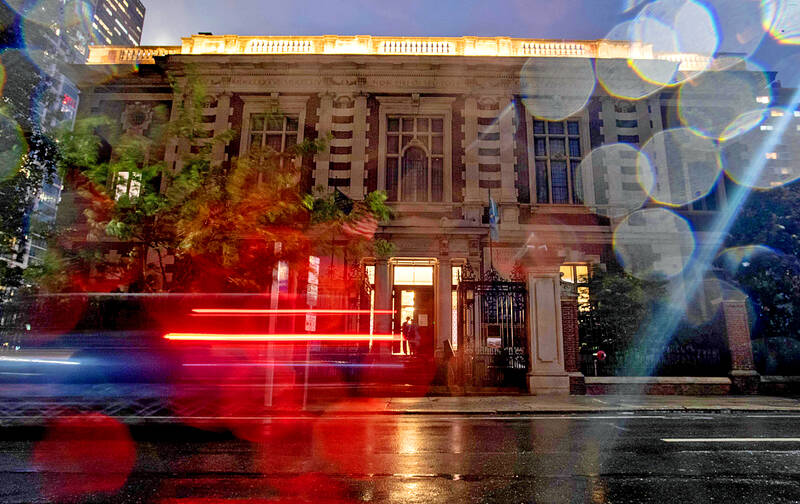For years, a man’s giant intestine was anonymously on display at a US medical museum in Philadelphia, identified only by his initials JW. Today, the donor display for Joseph Williams depicts not only his anatomical record, but his powerful life story.
After two years of controversy over how to ethically exhibit human remains, the Mutter Museum announced last week it has changed its policy to “contextualize” and de-anonymize its collection.
“The issue isn’t whether we should or shouldn’t exhibit human remains,” said Sara Ray, the museum’s senior director of interpretation and engagement. “But rather, can we do so in a way that does justice to these individuals and their stories as we trace the history of medicine, bodily diversity and the tools and therapies developed to treat them?”

Photo: AFP
Founded in 1963 from the personal collection of local surgeon Thomas Mutter, the museum is now home to 35,000 items, including 6,000 biological specimens. Visitors can view a vast medical library with human skulls, wax moldings of skin conditions, medical tools and more. Under its new policy, the museum will only accept donations from living donors or from their descendants, to help identify them.
In 2020, a heart transplant recipient donated his old enlarged heart to the collection. The organ, the size of a soccer ball, now floats in a jar next to a collection of 139 human skulls amassed by a 19th century Austrian anatomist.
POSTMORTEM PROJECT
In 2023, after a change of leadership, the Mutter launched the Postmortem Project, a two-year public engagement initiative to re-examine its collection and debate the ethics of displaying human remains.
As part of the reevaluation, the museum deleted hundreds of videos from its YouTube channel, which has over 110,000 followers, as well as a digital exhibition from its Web site.
“That’s when the controversy started,” recalls the Mutter’s former director Kate Quinn, who initiated the project. “They were internal conversations that became very prominent in the public sphere after the videos were removed from YouTube.”
She added: “We didn’t want to dramatically change the museum. That was never the intent. The intent was to bring people into the conversation and bring us along this journey as we’re trying to figure it out.”
The museum’s annual Halloween party, known as Mischief at the Mutter, was also canceled.
The backlash was swift.
A former director of the museum published a scathing op-ed in the Wall Street Journal, condemning “cancel culture” and accusing “a handful of woke elites” of jeopardizing the museum’s future.
Soon, an activist group called Protect the Mutter, was formed. Its petition calling for Quinn’s ouster garnered more than 35,000 signatures.
“The online content (was) just being decimated, and the staff changes and events,” an organizer at Protect the Mutter said on condition of anonymity.
Upset about the controversy, the heart transplant patient had at one point asked for his heart back before the museum made changes.
‘DID THESE PEOPLE CHOOSE?’
Along the corridors of this two-story brick building, visitors can see the cast figures of two adult Siamese twins or study small fragments of Albert Einstein’s brain.
They can also learn about the lives of Ashberry, the woman with dwarfism, and Williams, whose “megacolon” was 8 feet (2.4 meters) long. A typical human colon is about 5 feet long.
Similar controversies have also rocked several other Western institutions, such as the British Museum, in recent years, which anthropologist Valerie DeLeon says is part of a broader conversation on ethics.
Museum goers “are thinking about the people that are represented in those collections. And you know, did these people choose to be there? Are they being exploited by having their skeletal remains on display for ‘entertainment’?” DeLeon told AFP. Quinn left her post this spring and the museum’s new management moved to restore 80 percent of the videos on its YouTube channel, a decision welcomed by members of Protect the Mutter.
But more difficult questions remain, like what to do with the skeleton of a 2.29-meter giant who cannot be identified.
The anonymous Protect the Mutter activist believes it should be displayed.
“Let this example of acromegaly be respectfully displayed and help future generations better understand an ongoing condition that continues to affect people every day,” the activist said. “It becomes that acknowledgment, instead of erasing the past.”

On Sept. 23 at 2:50pm, the Mataian River (馬太鞍溪) landslide dam failed after the torrential rains brought by Typhoon Ragasa, releasing millions of tons of water that rushed downstream, reaching Guangfu Township (光復) in Hualien County at around 4pm. As of this writing, 18 have been confirmed dead from the flooding. The barrier lake was formed by a landslide in late July. First detected on July 26, it had been under extensive monitoring by central government authorities and researchers. Nothing could be done on the barrier dam itself because of the site’s remoteness — by government estimates nearly three years

Oct. 6 to Oct. 12 The lavish 1935 Taiwan Expo drew dignitaries from across the globe, but one of them wasn’t a foreigner — he was a Taiwanese making a triumphant homecoming. After decades in China, Hsieh Chieh-shih (謝介石) rose to prominence in 1932 as the foreign minister for the newly-formed Japanese puppet state of Manchukuo in today’s Northeast China. As ambassador to Japan, he was to represent the last Qing emperor Puyi (溥儀) at the event’s Manchuria Pavillion, and Taiwan’s governor-general welcomed him with the honors of a state guest. Hsieh also had personal matters to attend to — most

Despite an abundance of local dance talent, Taiwan has no renowned ballet company to call its own. But great troupes do visit — including the English National Ballet this past May. And once a year, Art Wave’s (黑潮藝術) annual Ballet Star Gala brings together some of the world’s pre-eminent principal dancers for a cornucopia of pas de deux. Organizer Wang Tzer-shing (王澤馨) said this year’s edition of the gala, to be staged today and tomorrow at the National Theater in Taipei, is exceptionally balanced between classical and modern ballet styles. Modern ballet pieces by prominent choreographers — Rudi van Dantzig, essential to

The Korea Times announced the results of K-universities Global Excellence Rankings 2026, the nation’s first comprehensive assessment of global performance across its universities. The evaluation was launched to provide an objective analysis of the globalization status of Korean universities and to offer practical guidance for international students choosing institutions in South Korea. KOREA UNIVERSITY RANKS FIRST In the overall rankings, Korea University secured first place with a total score of 144.86, followed by Seoul National University (141.48) and Yonsei University (140.33). Rounding out the Top 10 were Sungkyunkwan University (132.20), Hanyang University (124.83), Sogang University (112.27), University of Seoul (111.10), Ewha Womans